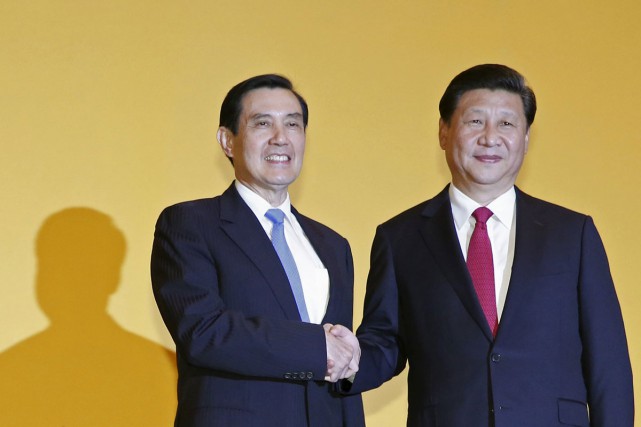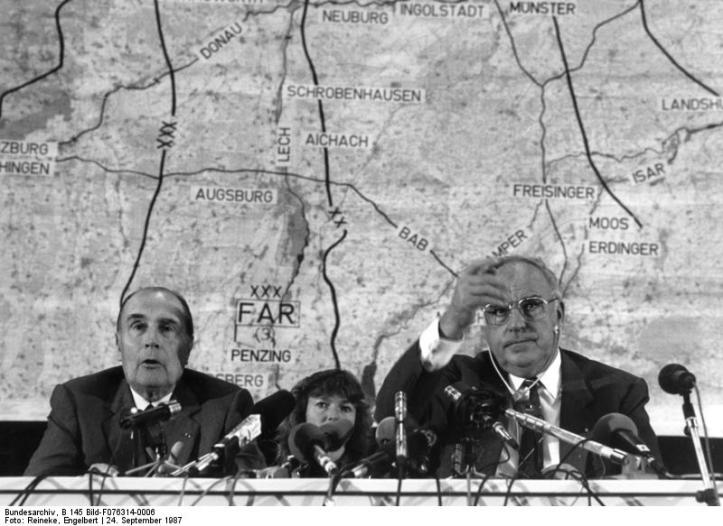At the end of September, President Ma Ying-jeou (馬英九) spoke with EU parliamentarians via videoconference in what will likely be one of his last foreign policy engagements. President Ma focused on foreign policy issues and emphasized the achievements of his two-term presidency, saying that cross-Strait relations were at all-time high as a result of his conciliatory policies and his East and South China Sea peace initiatives. More interestingly, and well suited for his audience, he drew several parallels between stories of post-World War Two rapprochement in Western Europe and what inspiration it can provide for cross-Strait relations.

Indeed, post-WWII developments offer some examples of good neighborly conduct that states in Northeast and Southeast Asia could try to emulate in order to overcome hurdles of their troubled history. However, one needs to bear in mind that these changes in Europe were happening in specific historical context that does not exist in contemporary relations in East Asia, let alone between China and Taiwan.
More specifically, President Ma listed three examples of post-WW2 Europe that he finds inspiring. The first is Franco-German rapprochement, which included extensive student exchanges. Second is the North Sea Continental Shelf settlement among the three claimant states: (West) Germany, Denmark, and The Netherlands. The third, and seemingly most fitting to the cross-Strait impasse, is the rapprochement between West and East Germany attained in the historical Basic Treaty of 1972 in which the two German states reached a consensus on how to treat each other as sovereign entities without compromising the ultimate goal of re-unification. This rapprochement also led to the admission of both states as UN members.
Franco-German reconciliation is a tempting example, but not for relations between China and Taiwan. Rather, it offers a few lessons for Beijing and Tokyo. Franco-German reconciliation was one of the key developments in post-war Europe, preparing the ground for future European integration. However, external factors played an important role. The looming Soviet threat and the U.S.-led collective security arrangements formed an environment that was conducive to Germany’s repentance and French acceptance thereof. In any case, France never challenged Germany’s statehood, and vice versa. Today there would not be a EU without France and Germany, and no European integration would be possible without the two cooperating.

That was the understanding back in late 1950s and that is the understanding today. However, China in 2015 is neither the France nor Germany of the 1950s. It is not leading regional integration to recover economically and to be better poised to face external challenges. Rather, in a manner that is reminiscent of the Soviet threat, Beijing is the primary challenge for other regional states. Taiwan and other neighbors of China can look to Europe’s integration and collective defense arrangement for some inspiration, but for whole different reasons than President Ma is offering.
A more interesting application of Franco-German reconciliation on Taiwan-China relations is student exchanges. As President Ma explained, prior to his first term, there were less than 1,000 Chinese students in Taiwan. Nowadays, the total number exceeds 30,000, both students on short-term stay and those seeking degrees. Student exchanges are indeed valuable. However, it is too soon to judge their impact. For instance, we do not know what the future will look like for Chinese students who graduate from Taiwanese universities or even those who come for short-term exchanges. There is a chance, greater than zero, that their experience and exposure to Taiwan’s democracy will be looked upon with suspicion after they return to China.
German re-unification must be a tempting example for everyone who wishes to see cross-Strait unification. However, it ultimately fails the reality test. To be fair, President Ma acknowledges the different historical context. Yet, it seems he does that for the wrong reason. Consider this: Germans on both sides never ceased to consider themselves Germans. Hence, German re-unification (Deutsche Wiedervereinigung) was the natural correction of a short-term division. Some resented its prospect, not because of a diverging identity, but because of the economic costs.
None of this applies to Taiwan. Today, only 3.5% people consider themselves Chinese against 59% Taiwanese and 33.7% expressing a dual identity, according to the longitudinal survey conducted by National Chengchi University’s Election Study Centre. When we corroborate those results with surveys that do not offer dual identity as an option, Taiwanese identity rises to as high as 80%, reaching even higher levels among youth. Therefore, the NCCU numbers are a rather conservative estimate.
There are certain merits to these comparisons. Perhaps one lesson that President Ma wanted to stress is that even enemies like France and Germany can become friends, or that divided entities can develop meaningful relations without one denying the existence and legitimacy of the other. Cross-Strait relations can be looked at from these two perspectives — if only Beijing were to accept the model of the Basic Treaty of 1972 and stopped blocking Taiwan’s full UN membership. Interestingly, post-Cold War Europe offers significantly more examples of state break-ups, most of them violent. However, the peaceful dissolution of Czechoslovakia is ultimately a more fitting case for the Sino-Taiwan issue than German unification.

The proposal that China-Taiwan relations are at an all-time high is to a considerable extent an illusion. It is true that relations were free from major tensions under President Ma. However, everywhere else the situation has deteriorated. The South China Sea has become increasingly unstable since 2009, especially following the recent base-building frenzy by Beijing. The situation has not been stable in the East China Sea either. Few in Manila or Tokyo would claim that relations are at an all-time high. This does not necessarily invalidate Ma’s assessment. However, Taiwan is not isolated from its volatile neighborhood, and since Beijing is an active element in tensions elsewhere, it forces us to re-evaluate the meaning of stable cross-Strait relations.
The fundamental problem with the current state of cross-Strait relation is that they have unstable foundations. In particular, the Chinese Communist Party (CCP) is inherently interested in the Chinese Nationalist Party (KMT) remaining in power. To preserve this KMT-CCP cross-Strait “equilibrium,” the CCP is willing to make certain compromises and not to react in overly harsh manner, knowing that KMT is, at least in theory, committed to eventual unification. Even in an environment that incentivizes caution, Beijing still puts forth unilateral measures, such as including Taiwan in its internal security legislation, unilaterally changing ID cards required for travel to China, or the declaration of M503 air route. While the CCP has an incentive to tolerate a KMT government, a KMT government too has incentive not to react too harshly to Beijing’s transgressions because it does not want to lose the image of a party that “manages” cross-Strait relations better. Fortunately for Taiwanese (and not so much for Beijing), Taiwan is not a party-state anymore, and governing parties will change irrespective of China’s preferences. However, it is precisely China’s preference for Taiwan to be a quasi-party-state with its preferred partner staying in power indefinitely that makes cross-Strait relations inherently unstable. No number of agreements and flights will correct the situation as long as Beijing is unwilling to approach its relations with Taipei on state-to-state, government-to-government basis.
Finally, Cold-War Europe has experienced ups and downs in terms of overall security. There were periods when threat from the Soviet Union and its satellites was more intense, and there were also periods of relative calm. The relatively constant factor throughout was that West European states had a formidable external challenge: the Soviet-led Eastern bloc. This is where President Ma’s third European resource-sharing inspiration falls flat. All states in the North Sea were part of the same military alliance, NATO, which precluded any chance for military confrontation among them. Nor did those states reach an agreement by themselves. Instead, they entrusted their claims to an impartial decision of the International Court of Justice.

Even today, it is rather common for European states to refer a dispute to a court and then abide by the ruling. It is hard to see the parallel in the case of South and East China Seas when the key claimant in these disputes rejects mediation by an international court and prefers instead to impose fait accompli on other claimants. President Ma’s peace initiatives are not doomed to fail due to excessive idealism. They are doomed to fail because Beijing is nowhere near accepting their guiding principles. The one success that President Ma can claim, the fishery agreement between Taiwan and Japan, is more a result of Japan’s geopolitical calculations than peace initiatives coming from Taipei.
To judge President Ma’s foreign policy record fairly is a job best left to future historians. It appears that Ma’s image abroad is better than at home, and his foreign policy initiatives (although he would probably disagree that cross-Strait relations are a foreign policy issue) are perceived abroad more positively than by Taiwanese, who are nevertheless the primary recipients of his policies. Ma can rightly claim that the ROC passport has become more valuable during his two terms as the number of countries granting visa-free treatment has risen substantially. Yet, every now and then, Taiwanese are reminded of their peculiar status and the humiliation is hard to overcome. This illusion of cross-Strait stability will be left to Ma’s successor in office, where Beijing is likely to shatter it sooner or later.
This piece is based on my talk in Prague organized by the Association for International Affairs on October 8, 2015, and was originally published on Thinking Taiwan on October 29, 2015.